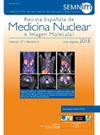Correlación entre los hallazgos de la PET/TC con [18F]FDG y los subtipos histológicos de adenocarcinoma de pulmón que se presentan como opacidad en vidrio deslustrado
IF 1.6
4区 医学
Q3 RADIOLOGY, NUCLEAR MEDICINE & MEDICAL IMAGING
Revista Espanola De Medicina Nuclear E Imagen Molecular
Pub Date : 2025-03-08
DOI:10.1016/j.remn.2024.500087
引用次数: 0
Abstract
Objective
The aim of this study is to analyze the correlation between [18F]-FDG PET/CT (positron emission tomography/computed tomography) findings and pathological subtypes of lung adenocarcinoma with ground-glass opacity (GGO).
Materials and methods
88 patients were included in this study, which underwent [18F]-FDG PET/CT and were finally diagnosed with lung adenocarcinoma. A total of 90 GGO lesions were analyzed. The size and SUVmax of all lesions were measured, the proportion of solid components of GGO in lesions was calculated, and quantitative classification was performed. The above GGO lesions were divided into three groups based on the 2011 IASLC/ATS/ERS lung adenocarcinoma pathological classification, namely good prognosis group, relatively good prognosis group and poor prognosis group. Chi-square test, independent sample t test, and analysis of variance were used for statistical analysis.
Results
There was a negative correlation between the SUVmax and quantitative classification value (r =−0.638, P < 0.001). Atypical adenomatous hyperplasia (AAH), acinar predominant adenocarcinoma (APA), lepidic predominant adenocarcinoma (LPA), papillary predominant adenocarcinoma (PPA), and solid pre-dominant adenocarcinoma (SPA) had significant differences in GGO lesion size, SUVmax, and quantitative classification value (F = 3.849, P = 0.019; F = 27.420, P < 0.001; F = 4.353, P = 0.002). There were significant differences in GGO lesion size, SUVmax, and quantitative classification value among the good prognosis group, relatively good prognosis group, and poor prognosis group (F = 5.626, P = 0.011; F = 37.587, P < 0.001; F = 5.119, P = 0.008).
Conclusion
GGO lesion size, SUVmax, and quantitative classification value are correlated with different pathological subtypes and can be used to evaluate the prognosis of lung adenocarcinoma with GGO.
PET/ CT与[18F]FDG的发现与以不透明玻璃形式出现的肺腺癌组织学亚型之间的相关性
目的分析[18F]-FDG PET/CT(正电子发射断层扫描/计算机断层扫描)表现与肺腺癌磨玻璃样混浊(GGO)病理亚型的相关性。材料与方法本研究纳入88例患者,经[18F]-FDG PET/CT检查,最终诊断为肺腺癌。共分析90例GGO病变。测量所有病变的大小和SUVmax,计算病变中GGO固体成分的比例,并进行定量分类。根据2011 IASLC/ATS/ERS肺腺癌病理分类将上述GGO病变分为预后良好组、预后较好组和预后较差组。统计学分析采用卡方检验、独立样本t检验和方差分析。结果SUVmax与定量分类值呈负相关(r = - 0.638, P <;0.001)。非典型腺瘤性增生(AAH)、腺泡显性腺癌(APA)、鳞状显性腺癌(LPA)、乳头状显性腺癌(PPA)和实体性显性腺癌(SPA)在GGO病变大小、SUVmax和定量分类值上存在显著差异(F = 3.849, P = 0.019;F = 27.420, P <;0.001;F = 4.353, p = 0.002)。预后良好组、预后较好组、预后较差组间GGO病变大小、SUVmax及定量分类值差异均有统计学意义(F = 5.626, P = 0.011;F = 37.587, P <;0.001;F = 5.119, p = 0.008)。结论go病变大小、SUVmax及定量分级值与不同病理亚型相关,可用于评价肺腺癌伴GGO的预后。
本文章由计算机程序翻译,如有差异,请以英文原文为准。
求助全文
约1分钟内获得全文
求助全文
来源期刊

Revista Espanola De Medicina Nuclear E Imagen Molecular
RADIOLOGY, NUCLEAR MEDICINE & MEDICAL IMAGING-
CiteScore
1.10
自引率
16.70%
发文量
85
审稿时长
24 days
期刊介绍:
The Revista Española de Medicina Nuclear e Imagen Molecular (Spanish Journal of Nuclear Medicine and Molecular Imaging), was founded in 1982, and is the official journal of the Spanish Society of Nuclear Medicine and Molecular Imaging, which has more than 700 members.
The Journal, which publishes 6 regular issues per year, has the promotion of research and continuing education in all fields of Nuclear Medicine as its main aim. For this, its principal sections are Originals, Clinical Notes, Images of Interest, and Special Collaboration articles.
 求助内容:
求助内容: 应助结果提醒方式:
应助结果提醒方式:


